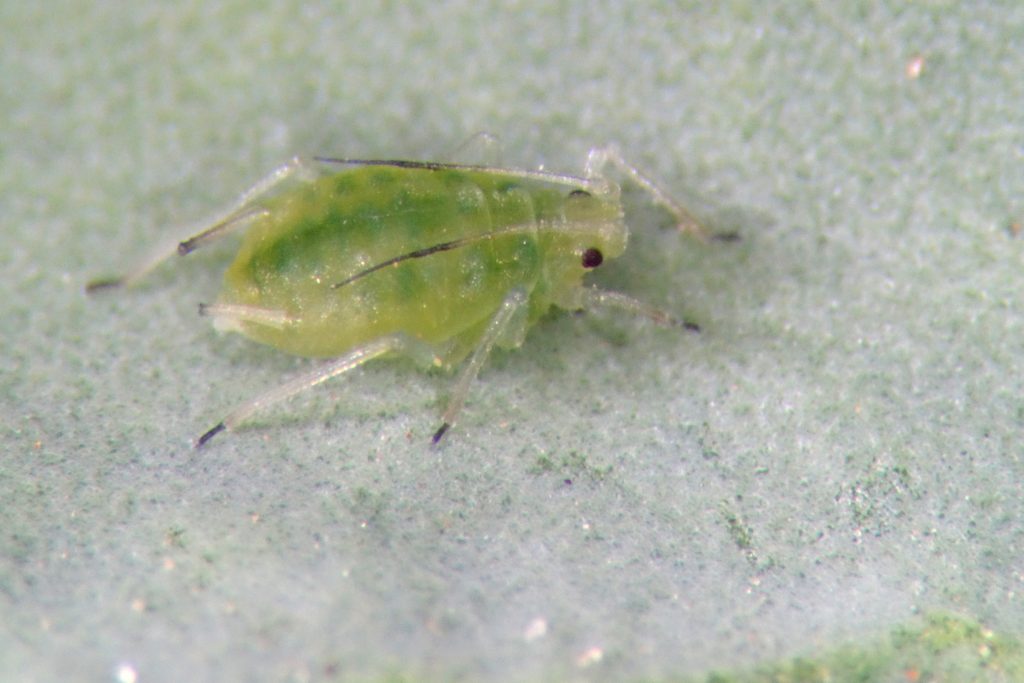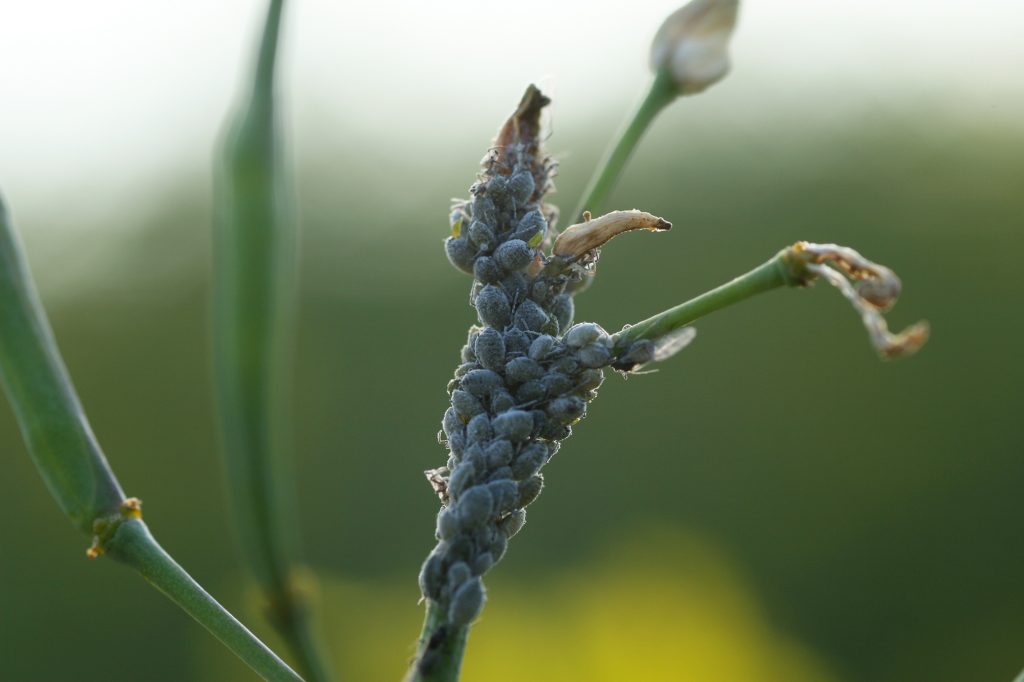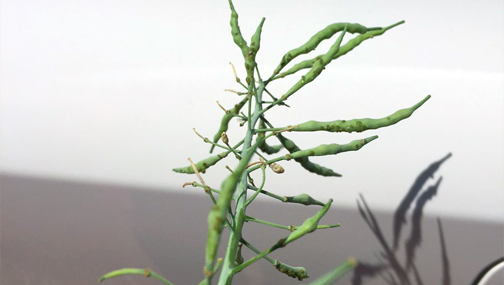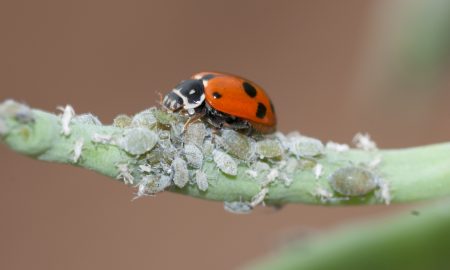Mild spring weather usually means two things for aphids.
Firstly, it speeds up aphid population growth, allowing these mini-clone machines to grow and reproduce at a much faster rate than throughout winter.
Secondly, it is a time of year when aphid flight activity is increasing, resulting in more movement and spread of aphids between crops.
Naturally, many growers and advisors note an increase in aphids at this time of year.
Here’s what to consider when scouting crops for aphids this spring:
1. Which aphid? (Start with the usual suspects)
Correct management always begins with correct identification.
While aphids can be polyphagous (feeds on many crop types), they do have preferred host types, and this is a major clue for identification
As a starting point, you should always ask, “Which aphids usually impact this crop?”.
The usual aphid suspects in broadacre crops are:
- Canola — turnip aphid, cabbage aphid, green peach aphid
- Cereals — oat aphid, corn aphid, Russian wheat aphid, rose-grain aphid
- Pulses — bluegreen aphid, pea aphid, cowpea aphid, green peach aphid
If your aphids don’t fit the description of any of the aphids usually found in that crop, then start to lookout outside of the square.
For aphid identification help, download Crop Aphids: The Back Pocket Guide or contact us.

Photo by Julia Severi, Cesar Australia 
Photo by Andrew Weeks, Cesar Australia
2. Be kind to, and trust in, your tiniest farm hands
Highly mobile, flight-capable beneficials insects (‘natural enemies’) increase in numbers around aphid colonies during spring. You may even see hoverfly and ladybird beetle adults looking for egg-laying spots amid aphid colonies. So, while aphids may build-up in high numbers– beneficials are usually hot on their tail.
Ladybird beetles, lacewings, damsel bugs, parasitoid wasps and hoverflies are just a few of the key groups that will follow and hunt down aphids.
But there is a time-lag between aphid population build up and the beneficials making an impact. Monitoring for trends in aphid and beneficial populations over time is key to determining the impact of these natural enemies.
With respect to parasitoid wasp activity, keep in mind that when an aphid host takes on the typical aphid mummy appearance, wasp development is almost complete. The level of parasitism in a crop may be higher than what can be seen by eye.
What’s more, beneficials can only do their best work if left uninterrupted. If broad spectrum chemicals are sprayed at this time of year, beneficial populations will take a hit. These sprays will be particularly impactful for any resident natural enemies, which will take time to recover. We recommend using softer, more selective chemistries for aphid control.
3. How many is too many?
There may be scenarios where beneficials just aren’t getting on top of aphid populations and spraying is warranted. Where possible we recommend using economic thresholds or ‘rule of thumb’ guides where available.
For example, the current threshold for cabbage aphid and turnip aphid in flowering canola is >20% of plants infested with colonies.
All available thresholds are available under their respective pests in our PestNote series.
Even when thresholds are available, it is critical to consider the current growing conditions and moisture availability. Crops that are not moisture-stressed have a greater ability to compensate for aphid damage and can tolerate higher infestations than moisture-stressed plants before yield loss occurs.
4. In the absence of thresholds…
Thresholds don’t exist for every aphid in every crop type unfortunately. In the absence of thresholds, as well as factoring in beneficial activity and current growing conditions, assess whether you are seeing any physical symptoms.
Aphids are sucking pests. They feed with needle-like mouth parts, with which they pierce plants and suck moisture and nutrients. Look out for wilting, distorting, leaf curling, leaf drop to help to determine if they are starting to impact your crop.
Also consider the distribution of the aphid population. If they are localised in the paddock, you could get away with spraying hot spots.
5. Is chemical control of green peach aphid in advanced canola really warranted?
Green peach aphid can be found in canola (and occasionally some pulses) at this time of year.
With respect to canola, green peach aphid tends to colonise the underside of leaves and is not typically expected to have an impact on yield in advanced canola. It is turnip aphid and cabbage aphid that are more problematic as they form dense colonies around flowers, pods and stems.
We have seen green peach aphid move up onto stems and pods, especially with senescence of lower leaves and in dry years, but any impact on yield and oil quality remains unclear. They don’t appear to colonise as densely as a cabbage or a turnip aphid would, but if you have seen otherwise, please let us know or send us a photo!

Photo Andrew Weeks, Cesar Australia 
Photo by Terry Edis
What’s more, chemical options for green peach control are very limited in late-stage canola crops. cesar research has found that > 90% of all green peach aphid populations collected from canola crops across Australia are highly resistant to synthetic pyrethroids (e.g. alpha-cypermethrin) and carbamates (e.g. pirimicarb). Applications of these chemicals, even at very high rates, will not control green peach aphid if these resistances are present.
The vast majority of green peach populations also possess resistance to organophosphates (e.g. dimethoate). However, the mechanism underlying this resistance is unusual in that it can be ‘switched on’ in response to particular stressors. Although risky, this means organophosphates can be effective in some instances. Anecdotal evidence suggests green peach aphid numbers can be reduced by up to 50% despite the presence of organophosphate resistance, although complete control failures have been known to occur (so there are no guarantees!).
Sulfoxaflor (Transform) is effective against green peach aphid, but it cannot be used on canola past full flower. Paraffinic oils are also registered against green peach aphid in canola, however these sprays will only suppress populations. Oils have the advantage of being soft on beneficial populations and have very short withholding periods.
Acknowledgements
Field reports
Matt Coffey – Elders (Northern Country VIC)
Bruce Larcombe – Larcombe Agronomy (Northern Country VIC)
Greg Parker – AGnVET Services (Riverina NSW)
Tim Pilkington – Southern Ag Management (North East VIC)
Tessa Sexton – Elders (Northern Country VIC)
Greg Toomey – Landmark (Northern Country VIC)
Casey Willis – Rodwells (Gippsland VIC)
Cover image: Photo by Andrew Weeks, Cesar Australia





